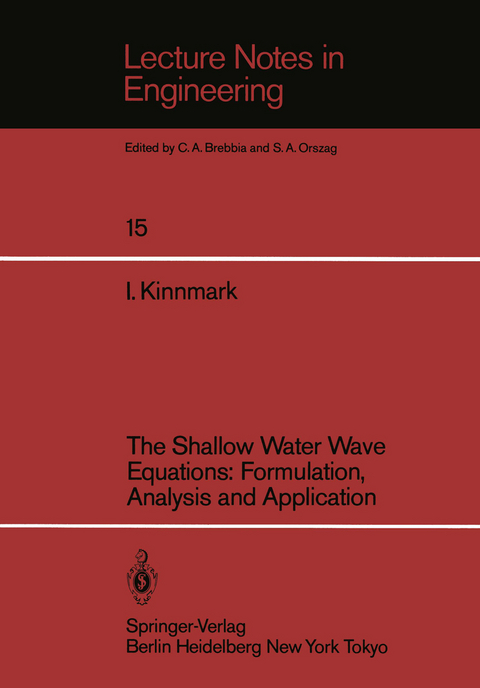
The Shallow Water Wave Equations: Formulation, Analysis and Application
Springer Berlin (Verlag)
978-3-540-16031-1 (ISBN)
I. Introduction.- Areas of Application for the Shallow Water Equations.- Finite Element Methods for Solution of the Shallow Water Equations.- Methods for Analyzing Spatial Oscillations in Numerical Schemes.- Methods for Analyzing Stability of Numerical Schemes.- II. Equation Formulation.- Primitive Equation Form.- Wave Equation Form.- Generalized Wave Equation Form.- Linearized Form of the Continuity and Momentum Equations.- III. Fourier Analysis Methods.- Fourier Analysis: An Accuracy Measure.- Amplitude of Propagation Factors Arising from Second Degree Polynomials.- IV. Stability.- General Concepts.- Routh-Hurwitz and Liénard-Chipart.- Routh-Hurwitz and Orlando.- Factorization of Higher Degree Polynomials into Lower Degree Polynomials.- Determination of Stability for a Product of Polynomials.- V. Explicit Methods Using Various Spatial Discretizations.- Equal Node Spacing and Constant Bathymetry in One Dimension.- Application to Unequal Node Spacing.- Applications with Even Node Spacing and Variable Bathymetry.- Application to a Rectangular Grid.- VI. Implicit Methods.- Reducing the Number of Time Dependent Terms in the Matrix for the Wave Equation.- Explicit Treatment of the Coriolis Term in an Implicit Wave Continuity Equation.- Repeated Back Substitutions Replacing Decompositions.- The Generalized Wave Continuity Equation.- VII. Spatial Oscillations.- N-Dimensional Uniform Rectangular Grid.- N-Dimensional Nonuniform Rectangular Grid with Multi-Information Nodes.- Leapfrog Scheme and Wave Equation Formulation on Linear Elements.- Leapfrog Scheme and Wave Equation Formulation on Quadratic Elements.- The Use of Dispersion Analysis in Evaluating Numerical Schemes.- The 2?x Test: Assessing the Ability to Suppress Node-to-Node Oscillations.- VIII. TemporalOscillations.- Numerical Artifacts.- A Different Three Time Level Approximation of the Momentum Equations.- A Two Time Level Approximation of the Momentum Equations.- IX. Applications.- Application to Quarter Circle Harbor.- Application to the Southern Part of the North Sea - I.- Application to the Southern Part of the North Sea - II.- X. Conclusions.- A. Equivalent Formulations of Conditions Which Guarantee Roots of Magnitude Less than Unity.
| Erscheint lt. Verlag | 1.11.1985 |
|---|---|
| Reihe/Serie | Lecture Notes in Engineering |
| Zusatzinfo | XXVI, 188 p. |
| Verlagsort | Berlin |
| Sprache | englisch |
| Maße | 170 x 244 mm |
| Gewicht | 381 g |
| Themenwelt | Naturwissenschaften ► Biologie ► Ökologie / Naturschutz |
| Naturwissenschaften ► Geowissenschaften ► Meteorologie / Klimatologie | |
| Technik ► Bauwesen | |
| Technik ► Umwelttechnik / Biotechnologie | |
| Schlagworte | Finite Element Method • Fluid • fourier analysis • Friction • Information • Mass • Operator • Peat • Pressure • pressure gradient • stability • Water • Water Quality and Water Pollution • wave equation • Wind |
| ISBN-10 | 3-540-16031-0 / 3540160310 |
| ISBN-13 | 978-3-540-16031-1 / 9783540160311 |
| Zustand | Neuware |
| Informationen gemäß Produktsicherheitsverordnung (GPSR) | |
| Haben Sie eine Frage zum Produkt? |
aus dem Bereich


